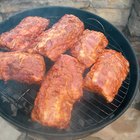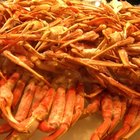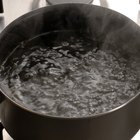Lcc54613/iStock/GettyImages
A popular dish in Southern cuisine and Caribbean cooking, pig feet do require a leap of faith for the uninitiated but are far more subtle and rewarding than might be expected. Properly prepared, the feet yield a soft, gelatinous flesh which absorbs all the flavors from the broth it is cooked in. The dish has a misguided reputation as a budget substitute for choicer cuts, but this does not explain its presence on gourmet metropolitan menus where cost-cutting is not a priority. Pig feet dishes use the forelegs of the hog, which are removed below the knee joints.
Boiled Pigs' Feet
Clean the pig feet thoroughly under cold running water. Despite their less than salubrious past, pig feet today are typically sold in pristine condition with all traces of dirt removed. Rinsing, however, will remove any accumulated fluids or remaining foreign bodies.
Remove any hairs or bristles. Although they are completely harmless, the hairs that grow around the trotter are unappetizing. Shave them off with a razor, snip away with scissors, or remove by singing them over a burner on the stove.
Split the feet in half lengthwise on the cutting board with the knife. Some butchers already sell the feet pre-cut.
Place the feet in a large pot and cover with water. Add seasoning, spice, aromatics and stock vegetables such as onions and carrots. A cup of white vinegar will also help break down the proteins in the meat.
Bring the pot to the boil and cover. Lower the heat and allow to simmer for around three hours. The feet should be tender, not falling apart.
Stir regularly and remove any foam that collects on the surface with a slotted spoon or skimmer.
Remove the feet from the broth with a slotted spoon and allow to drain. They can be eaten as is, or marinated in lime juice, cucumber and chopped onion to make a Caribbean “souse.” In Southern cooking, they might also be covered in barbecue sauce and heated in the oven at 300 F for around 15 minutes.
Related Articles
How to Boil Chicken Feet

How to Cook Neck Bones & Pig Feet

Baked BBQ Chicken Recipe

How to Cook Pig Snouts and Lips

How to Cook Lightning Whelks

How to Quickly Cook Fork-Tender Ribs

How Long Do You Need to Boil Large ...
How to Boil Pork Jowl Bacon

How to Smoke Ribs With a Gas Smoker

Difference Between Boiled & Grilled ...

Difference Between Fryer & Roaster ...

How to Eat King Crab Legs
How to Cook Frozen Langoustine
How to Cook Pork Neckbones in a Slow ...

How to Cook With Pork Jowl

Can You Bake Sliders?

How to Cook Pig Tails

How to Barbecue Ribs With a Gas Grill

How to Make Schmaltz Herring

How to Cook a Frozen Pork Fillet in the ...
References
Resources
Tips
- Pig feet are a leaner alternative to pork cuts that one might guess to be less fatty. They contain more protein and less fat, for example, than ribs. Feet are also rich in collagen, which slows down ageing. As the delicacy “Ashitibichi,” pigs' feet form a significant source of protein in the Okinawan diet, famed for its healthy properties. The gelatin in the broth is thought to protect knee ligaments.
- Don’t throw away the broth that the feet are cooked in. It is the perfect base for cooking greens or vegetables.
- To cook pigs’ feet in a fraction of the time – around 35 minutes – prepare them in a pressure cooker rather than a conventional pot.
- To add richness and depth to any pork or ham stew or soup, add a pigs' foot. This strategy works especially well if you want the added flavor but you don't want to actually eat the pigs' foot itself.
Warnings
- If using the pressure cooker, do not overfill with liquid.
- Despite their past as the lowest part of a pig, trotters are surprisingly delicate and will fall apart if overcooked. Monitor the feet regularly.
Writer Bio
Nick Marshall is a UK-based writer specializing in trends and best-practice in the B2B sector.